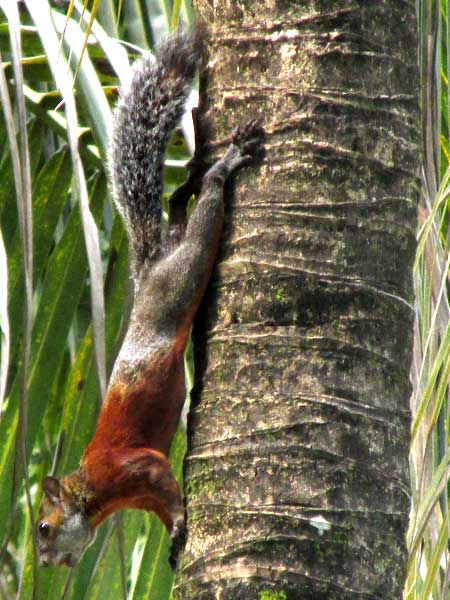Excerpts from Jim Conrad's
Naturalist Newsletter
from the November 16, 2018 Newsletter with notes from a camping trip in Chiapas, MÉXICO
RED-BELLIED SQUIRREL

Last month on October 4, during my camping trip to Mexico's southernmost state of Chiapas, I was resting on the excellent walkway/bike path between Palenque National Park and the town of Palenque, when I was distracted by a pair of Golden-fronted Woodpeckers issuing alarm calls. Just below the crown of a tall Coconut Palm planted along the way, the birds were orbiting around a squirrel clinging head-down on the side of the palm's trunk, flicking his tail. His cheeks bulged from something carried in his mouth, and I wouldn't have been surprised if it were a woodpecker egg or nestling. That's him above.
With the bright rusty coloration on his front end he's clearly a different kind of squirrel than the gray squirrels we're used to. In the squirrel genus Sciurus, 28 species are recognized, and four species are listed for neighboring Guatemala, so it's probably about the same for Chiapas.
This is a Red-bellied Squirrel, SCIURUS AUREOGASTER, sometimes also known as the Mexican Gray Squirrel. Among the squirrel species found in this region, only the Variegated Squirrel, Sciurus variegatoides, bears such rusty coloration, but on that species the rustiness occurs more to the rear, is less prominent, plus a black stripe or a hint of a stripe normally runs along the squirrel's spine. Our Red-bellied Squirrels are endemic to central and southern Mexico and Guatemala, plus they've been introduced into the US's Florida Keys.
This is an adaptable species, in Mexico occurring from sea level to 3300m (10,00ft), from lowland tropical broadleaf forests like those at Palenque to conifer forests and even savannas. Mostly Red-bellied Squirrels eat acorns and pine nuts, but also they feed on fungi, insects, eggs and nestlings, plus a variety of fruits ranging from green figs to tamarind pods and palm nuts. At Palenque there are no oaks or pines, so they may put special pressure on nesting birds.
On the Internet, Mammology.Org offers a free PDF providing plenty of life history information on the species. Search for the article published in the journal Mammalian Species 49(951):81-92, entitled "Sciurus aureogasters Rodentia: Sciuridae), by John Koprowski and others.
from the July 20, 2007 Newsletter issued from Sierra Gorda Biosphere Reserve, QUERÉTARO, MÉXICO
RED-BELLIED SQUIRRELS
Oaks and walnuts were common on the slopes and ridges south of Pinal de Amoles, and there were squirrels. They struck me as looking and behaving exactly like North America's Gray Squirrels except that they looked as if they'd been crouching in orangish French dressing; their bellies and the backs of their legs were bright, rusty-orange. The squirrels were Red-bellied Squirrels, SCIURUS AUREOGASTER. As far as I can tell, other than their French dressing, the only big difference between them and northern Gray Squirrels is that the literature reports that they bear litters of one to two young anytime during the year, while birthing among northern Gray Squirrel is seasonally synchronized.